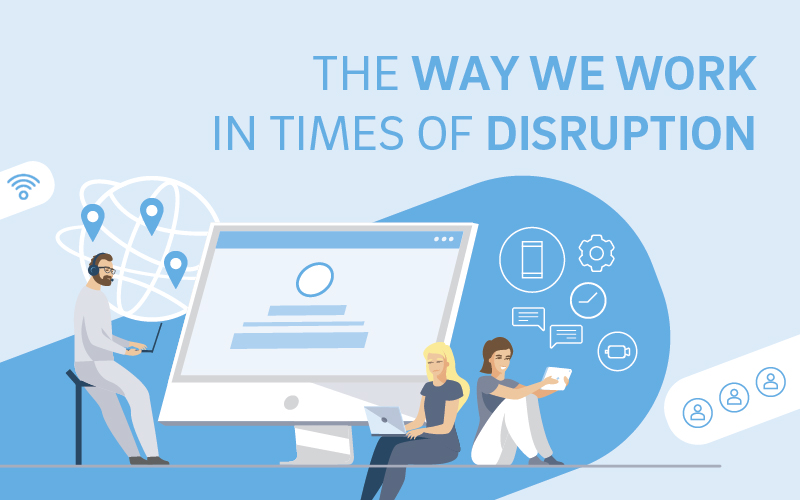Many things we think of as “normal” tend to get challenged when the unexpected happens. Business disruption may be a threat, but it is also important to remember that being forced out of its comfort zone can make a business more responsive and help it to find new and better ways to operate.
One of the main disruptions we are facing nowadays is how much the workplace has changed. With the rise in mobile working and now the Coronavirus pandemic, traditional office space has lost much of its importance. The crisis forced entire companies to work from home at least for a period of time, and it turned out that they could do so without a loss in productivity.
Many businesses are now transitioning to a mix of office-based and remote working. This new, blended environment still has to deliver a consistent experience; no matter where they are, people need the right technology and tools. Collaboration solutions have become increasingly popular as outdated processes are starting to make way for a new mentality that’s all about flexibility, efficiency and agility.
Achieving digital wellbeing
Of course, the ability to work anywhere, anytime brings with it new challenges as there is no longer a clear demarcation between home and work life. The questions employers should be asking right now are:
- How can we make remote working feel less remote?
- How can we nurture our employees and help them improve their work-life balance?
Ultimately, it’s all about better communication and collaboration, as well as simplifying tasks with more automation. People need to feel safe; most also crave a sense of achievement. A working environment that feels as close to ‘normal’ as possible allows employees to complete their daily tasks, manage their projects and make progress – in short, people want to feel in control. Technology plays a key role in this, helping employees stay engaged, connected and creative, working together in teams and keeping communication channels buzzing.
With a distributed workforce, the focus simply shifts from the physical workplace to workspace technology. Organisations should look for solutions that are fast, real-time and reliable – regardless of internet connectivity, there must be a fallback feature to guarantee consistent performance. Omni-channel platforms keep business communication flowing, while ease of use is an important factor for seamless adoption.
All this doesn’t necessarily require a big investment in the middle of a global crisis. Businesses can make the most of what they already have by adopting tools that help them integrate their existing solutions for a better outcome.
Bringing you the “new normal”
At NFON, we have been creating the “new normal” since 2007, with technology that allows business to operate from anywhere, at any time. Our focus is on helping organisations reach cost efficiency and manage their high-cost internal resource footprint more effectively, which we know is particularly important in times of uncertainty.
Our solutions are made for collaboration – such as virtual meetings and conferencing – while enabling employees to communicate easily over the phone when email and instant messaging are not sufficient or internet bandwidth at home is low.
Cloudya, our cloud telephone system, lets businesses establish open lines of conversation, whether across internal teams or with clients. With the increasing adoption of collaboration tools such as Microsoft Teams, we developed Nvoice for Microsoft Teams to allow organisations to also integrate these powerful telephony features into their familiar Microsoft environment. Together, these two tools offer a seamless user experience for users, whether they are working at home, in the office or on the move.
To make technology work better for you, find out how we can help your business adapt to the current challenges. Get in touch today.
020 3740 6740









